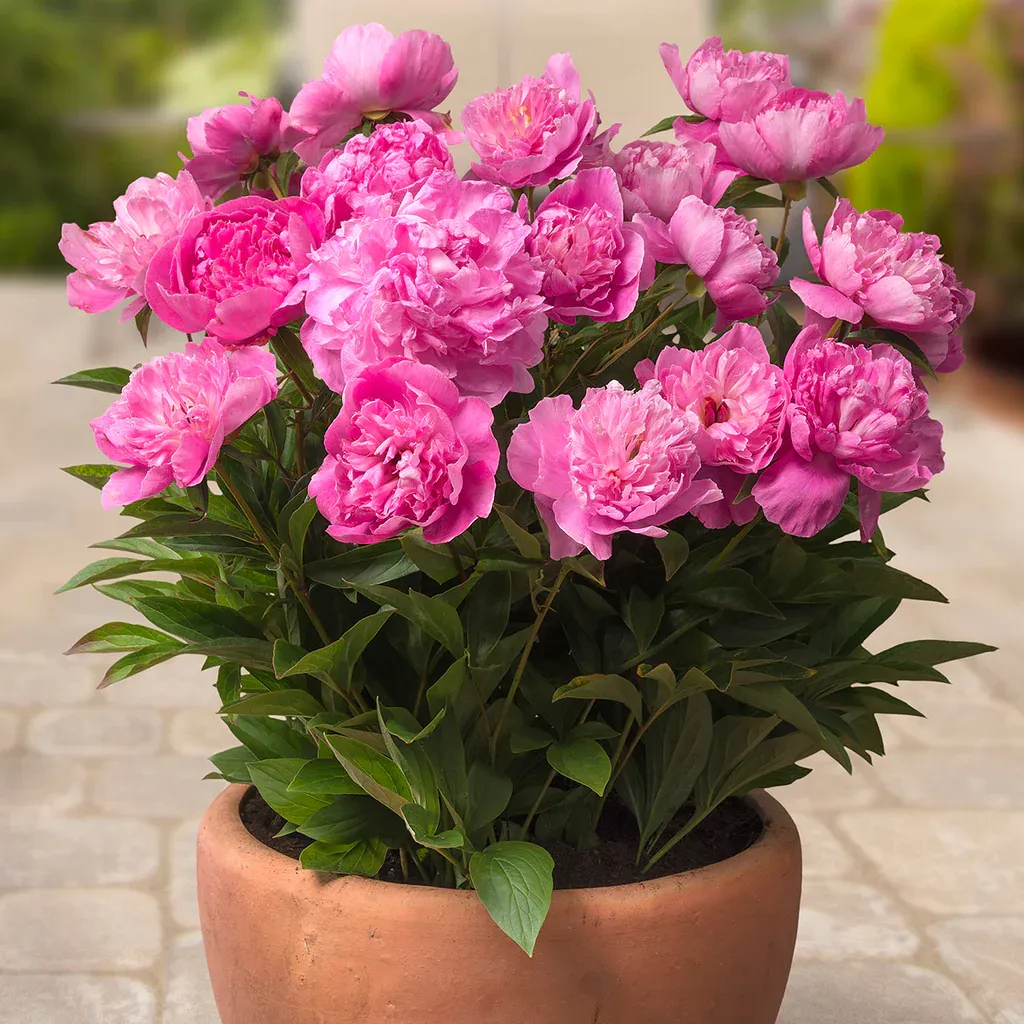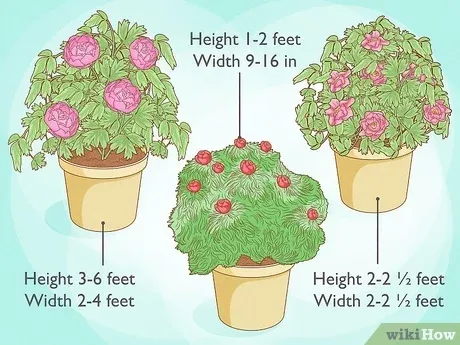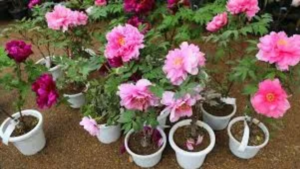Discover the secrets to cultivating stunning peonies in pots. Our detailed guide covers pot selection, planting, care, and more for thriving peony plants on your patio or balcony.
Introduction: Peonies in Pots
Peonies are undoubtedly one of the most captivating and beloved flowers in the gardening world. Their lush, fragrant blooms have the power to transform any outdoor space into a true oasis of beauty. While peonies are traditionally grown in the ground, did you know that you can also enjoy their splendor by growing them in pots? That’s right! With the right techniques and a little TLC, you can bring the enchanting world of peonies right to your patio, balcony, or even indoors.
In this comprehensive guide, we’ll take you on a journey through the art of growing peonies in pots. Whether you’re a seasoned gardener or a beginner, you’ll discover the secrets to selecting the perfect pot, planting your peonies with care, providing the ideal growing conditions, and keeping your plants healthy and thriving. Get ready to unlock the full potential of these stunning flowers and transform your outdoor living space into a true oasis of floral elegance.
Choose the Right Pot for Peonies
Once you’ve selected the perfect pot, it’s time to plant your peonies:
- Timing is Everything: The ideal time to plant peonies in pots is in the fall, between September and October. Planting during this cooler season allows the roots to establish themselves before the winter chill sets in.
- The Potting Mix: Peonies thrive in well-draining, slightly acidic soil. Create a potting mix using equal parts of potting soil, compost, and coarse sand. This combination provides optimal drainage, aeration, and nutrients.
- Planting the Peony:
- Bare Root Peonies: If you’re planting a bare-root peony, gently spread the roots out in the pot. Position the “eyes” (the small bumps where new growth emerges) facing upwards and no more than 1-2 inches below the soil surface.
- Peony Plants: For established peony plants, ensure the crown (the area where the roots and stems meet) sits level with the soil surface.
- Watering Wisely: Water your newly planted peonies thoroughly until water runs out the drainage holes. After that, water deeply when the top inch of soil feels dry to the touch. Avoid overwatering, as this can lead to root rot.
Pot Size Matters
The foundation for happy peonies in pots starts with selecting the perfect container. Here’s what you need to consider:
- Size Matters: Peonies are not shy about their root systems. They have deep taproots that require ample space to grow and flourish. Opt for a pot that’s at least 20 inches deep and wide. This allows for proper root development and ensures your peonies have the resources they need to thrive.
- Drainage is Key: Peonies detest soggy conditions. Select a pot with several drainage holes at the bottom to prevent water from accumulating around the roots. Excess moisture can lead to root rot and ultimately, the demise of your plant.
- Material Musings: There’s a wide variety of pot materials to choose from. Consider these factors when making your selection:
- Plastic: Lightweight, affordable, and readily available. However, plastic pots tend to dry out faster, requiring more frequent watering. Opt for double-walled plastic pots for better insulation during winter.
- Terracotta: Classic and aesthetically pleasing, terracotta allows for good air circulation and drainage. The downside is that it can dry out quickly and may crack in freezing temperatures.
- Glazed Ceramic: Offers a decorative touch and helps retain moisture. Be sure to choose pots with drainage holes, and remember that glazed ceramic pots can be heavy when filled with soil.
Material Matters
When it comes to pot material, you have several options, each with its own advantages. Terracotta pots are a classic choice, as they are porous and allow the soil to breathe, which can be beneficial for peonies. However, terracotta pots can also dry out more quickly, requiring more frequent watering. Plastic or resin pots are another option, as they are lightweight and durable. Wooden planters or half-barrels can also work well, but be sure to choose a material that is rot-resistant.
Drainage is Key
Regardless of the pot material you choose, ensuring proper drainage is essential for the health of your peony plants. Peonies cannot tolerate wet, soggy soil, so make sure your pot has ample drainage holes at the bottom. You can also add a layer of gravel or small stones to the bottom of the pot to improve drainage and prevent waterlogging.
Plant Peonies in Pots Properly
Planting your peonies in pots requires a bit of care and attention, but with the right techniques, you can ensure a successful start for your plants.
Soil Preparation
Peonies thrive in well-draining, nutrient-rich soil. Use a high-quality potting mix specifically formulated for containers, or create your own blend by mixing equal parts of compost, peat moss, and a coarse material like perlite or sand. This will provide the perfect balance of moisture retention and aeration for your peony plants.
Planting Depth
When planting your peonies, it’s crucial to get the depth right. The eyes (or buds) of the peony plant should be planted about 2-3 inches (5-7 cm) below the soil surface. This will ensure the plant has enough energy stored in the eyes to produce strong, healthy growth in the spring.
Spacing
Peonies need ample space to spread out their roots and foliage. Plant your peony tubers about 3-4 feet (90-120 cm) apart in the pot, allowing enough room for the plants to mature without becoming overcrowded.
Mulching
After planting, apply a 2-3 inch (5-7 cm) layer of organic mulch around the base of the plant. This will help retain moisture, suppress weeds, and insulate the roots during the colder months.
Find the Correct Spot
Choosing the right location for your potted peonies is crucial for their success. Peonies have specific light and temperature requirements that must be met.
Sunlight Needs
Peonies thrive in full sun, requiring at least 6 hours of direct sunlight per day. Aim to place your potted peonies in a spot that receives ample sunlight throughout the day, such as a sunny patio, balcony, or deck.
Temperature Considerations
Peonies prefer cool, temperate climates. They require a period of cold dormancy during the winter months to properly set buds and bloom in the spring. If you live in a warm climate, you may need to provide some additional cooling for your potted peonies, such as moving them to a shaded area or even into a garage or shed during the hottest months.
Airflow and Drainage
Peonies also benefit from good air circulation and well-draining soil. Avoid placing your potted peonies in areas with poor air flow or where water can accumulate, as this can lead to fungal diseases and other issues.
Watering the Peonies
Peonies require consistent moisture throughout the growing season, but avoid waterlogging. Here’s a watering strategy to follow:
- Spring and Summer: Water your potted peonies deeply when the top inch of soil feels dry to the touch.
- Fall and Winter: As temperatures drop and the plant goes dormant, reduce watering frequency significantly. Water only when the soil feels very dry to the touch.
Watering Frequency
During the growing season, water your potted peonies when the top inch (2.5 cm) of soil becomes dry to the touch. This is typically about once or twice a week, depending on your climate and the size of the pot. Avoid letting the soil become completely dry, as this can stress the plant and inhibit growth.
Watering Technique
When watering, be sure to thoroughly soak the soil, allowing the water to penetrate down to the roots. Avoid getting water on the foliage, as this can promote fungal diseases. If possible, water in the morning or evening to minimize evaporation.
Adjusting for Seasons
In the winter, when your peonies are dormant, reduce watering to just enough to keep the soil from completely drying out. During the spring and summer growing seasons, increase watering as needed to maintain consistently moist (but not waterlogged) soil.
Overwintering Peonies in Pots
Peonies require a period of cold dormancy to thrive, so proper overwintering care is essential for potted plants.
Protecting the Roots
As the weather turns colder, it’s important to insulate the roots of your potted peonies to prevent them from freezing. You can do this by wrapping the pot in burlap, straw, or even placing it in a larger container filled with mulch or leaves.
Cutting Back Foliage
Once the foliage has died back in the fall, cut the stems down to just a few inches (5-10 cm) above the soil surface. This will help the plant focus its energy on developing strong roots and buds for the next growing season.
Providing Cold Exposure
Peonies need a period of cold, typically around 6-8 weeks of temperatures below 40°F (4°C), to properly set their buds and bloom in the spring. If you live in a warm climate, you may need to move your potted peonies to a cooler location, such as a garage or shed, to ensure they receive the necessary cold exposure.
Avoid Peony Pests and Diseases
While peonies are generally quite hardy, they can still be susceptible to certain pests and diseases, especially when grown in containers.
Common Pests
Thrips: These tiny insects can damage flowers and foliage. Look out for distorted buds and discolored leaves. Treat with organic insecticidal soap.
Aphids: Look for these small sap-sucking insects on new growth. A hard blast of water or insecticidal soap can help control them.
Fungal Diseases
Peonies are prone to fungal diseases like botrytis blight, powdery mildew, and root rot. Ensure proper air circulation, avoid getting water on the foliage, and promptly remove any affected plant parts to prevent the spread of disease.
Preventive Measures
Good Sanitation: Remove fallen leaves and debris from around the base of the plant to minimize disease risk.
Adequate Air Circulation: Good air circulation helps prevent fungal diseases. Space out your potted peonies appropriately.
Monitor: Regular inspections help identify issues early on, increasing your chances of successful treatment.
Best Peony Varieties for Growing in Pots
Not all peony varieties are created equal when it comes to growing in containers. Here are some of the best options for potted peonies:
Itoh Peonies
Also known as intersectional peonies, Itoh peonies are a hybrid between tree peonies and herbaceous peonies. They are compact, well-suited for containers, and produce stunning, large blooms in a variety of colors.
Compact Herbaceous Peonies
‘Bowl of Beauty’: Large, fragrant pink blooms with yellow centers.
‘Early Scout’: Compact and free-flowering with vibrant, fuchsia-colored blooms.
‘Festiva Maxima’: Classic white peony with red flecks.
Miniature Peonies
For the ultimate in container-friendly peonies, consider miniature varieties like ‘Peppermint,’ ‘Fairy Princess,’ and ‘Raspberry Sundae.’ These petite plants can thrive in smaller pots and still produce charming, albeit smaller, blooms.Remember to always choose peony varieties that are suitable for your USDA hardiness zone and growing conditions to ensure the best possible results.
What are the best peony varieties for growing in pots?

Some of the best peony varieties for growing in pots include:
- ‘Sarah Bernhardt’ – A stunning pink double peony variety that produces huge blooms
- ‘Karl Rosenfield’ – Offers dark and dramatic blooms
- ‘Oslo’ – A compact variety well-suited for containers
- ‘Kiev’ – Another good compact option
- ‘Dublin’ – Performs well in pots
- ‘Border Charm’ – An intersectional peony hybrid that is more compact
- ‘Bartzella’ – An Itoh peony that blooms later in the season
- ‘Gay Paree’ – A compact variety
- ‘Magical Mystery Tour’ – Grows well in pots
When choosing a peony variety for a container, look for dwarf or compact types that won’t quickly outgrow their space. Intersectional peonies (Itoh) and some herbaceous varieties tend to have a more compact, rounded growth habit that works well in pots. Consider bloom time and flower form as well to extend the flowering season and choose your preferred aesthetic.
What is the ideal soil type for growing peonies in pots?

The ideal soil type for growing peonies in pots is a well-draining, nutrient-rich potting mix. Specifically:
- Peonies thrive in slightly acidic soils with a pH range of 6.5 to 7.01. Tree peonies can handle slightly more acidic soils than herbaceous and Itoh peonies.
- A soil-based potting compost mixed with peat-free compost at a 50:50 ratio, along with 10% grit and 10% extra leaf mold, provides excellent drainage and nutrients4.
- Avoid heavy clay soils, which can become waterlogged. Adding organic materials like compost can help improve drainage in clay soils.
- Sandy soils are not ideal as they drain too quickly and lack nutrients. Silt and loam soils provide a good balance of drainage and fertility.
The key is to use a light, well-draining potting mix that retains moisture and nutrients without becoming soggy. Amending the soil with compost, perlite, or other organic materials can help create the ideal growing medium for peonies in containers.
Conclusion
Growing peonies in pots brings the joy of these magnificent blooms within reach, even if garden space is limited. By following the guidance in this article – selecting the right pot, planting properly, ensuring adequate sunlight and water, overwintering effectively, and choosing suitable varieties – you’ll be rewarded with stunning, fragrant flowers year after year. Happy gardening!

I loved as much as youll receive carried out right here The sketch is attractive your authored material stylish nonetheless you command get bought an nervousness over that you wish be delivering the following unwell unquestionably come more formerly again as exactly the same nearly a lot often inside case you shield this hike